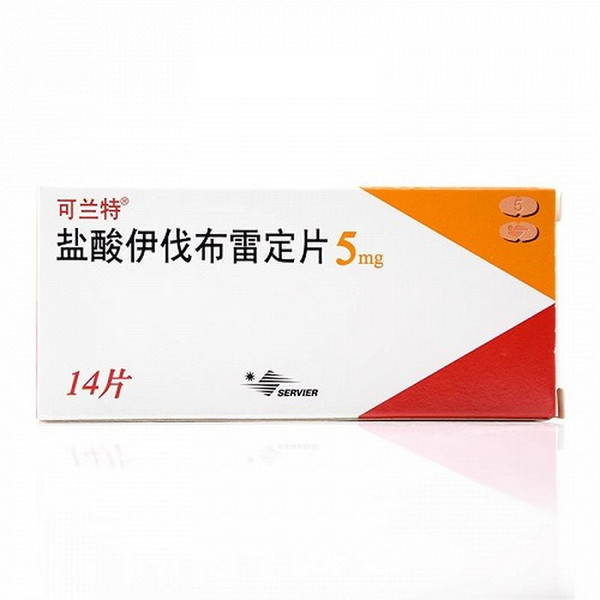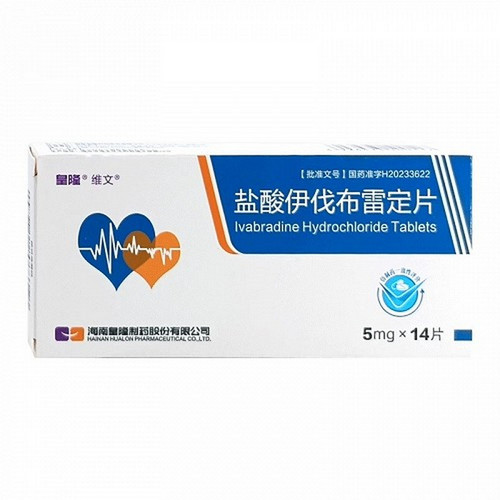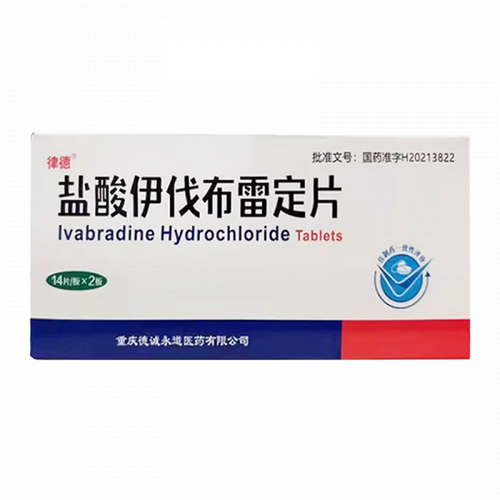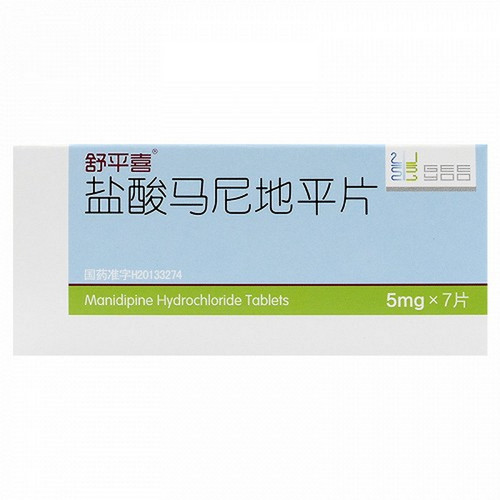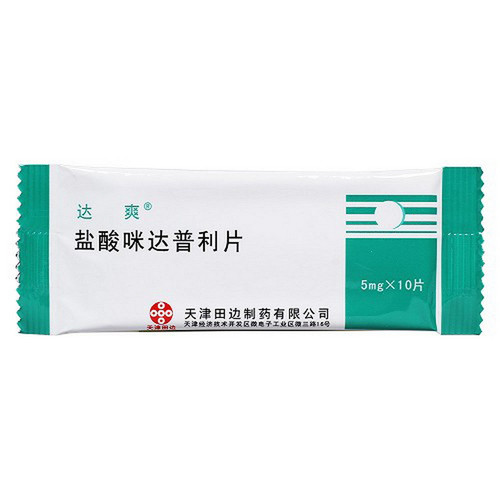Product Overview
[Drug Name]
Generic Name: Ivabradine Hydrochloride Tablets
Trade Name: Kelante
English Name: Ivabradine Hydrochloride Tablets
Chinese Pinyin: Yansuan Yifabuleiding Pian
[Ingredients]
The active ingredient of this product is ivabradine hydrochloride. Chemical Name: 3-(3-{[((7S)-3,4-dimethoxybicyclo[4.2.0]octa-1,3,5-trien-7-yl)methyl]methylamino}propyl)-1,3,4,5-tetrahydro-7,8-dimethoxy-2H-3-benzazepin-2-one, hydrochloride. Molecular Formula: C₂ₐH₃₆N₂O₅•HCl. Molecular Weight: 505.1
[Properties]
This product is an orange film-coated tablet. The 5mg tablet is oval, and the 7.5mg tablet is triangular. The tablet appears white after removal of the coating.
[Indications]
Indicated for use in patients with NYHA class II-IV chronic heart failure in sinus rhythm with a heart rate ≥75 beats/minute and associated systolic dysfunction, in combination with standard therapy including beta-blockers, or when beta-blocker therapy is contraindicated or intolerant.
[Dosage and Administration]
Oral administration, twice daily, with meals in the morning and evening (see Pharmacokinetics). Initial treatment with this product is limited to patients with stable heart failure. It is recommended that this product be used under the guidance of a physician experienced in treating chronic heart failure. The recommended starting dose is 5 mg twice daily. After two weeks of treatment, if the patient's resting heart rate remains above 60 beats/minute, the dose should be increased to 7.5 mg twice daily. If the patient's resting heart rate remains below 50 beats/minute or symptoms related to bradycardia, such as dizziness, fatigue, or hypotension, occur, the dose should be reduced to 2.5 mg (half a 5 mg tablet) twice daily. If the patient's heart rate is between 50 and 60 beats/minute, the dose should be maintained at 5 mg twice daily. During treatment, if the patient's resting heart rate remains below 50 beats/minute, or symptoms related to bradycardia occur, the dose of 7.5 mg or 5 mg twice daily should be reduced to the next lower dose. If the patient's resting heart rate remains above 60 beats/minute, the dose of 2.5 mg or 5 mg twice daily should be increased to the next higher dose. If the patient's heart rate remains below 50 beats/minute or bradycardia symptoms persist, the drug must be discontinued (see Precautions). Special populations Patients with renal insufficiency: No dose adjustment is required for patients with renal insufficiency and creatinine clearance greater than 15 ml/min (see Pharmacokinetics). There are no clinical data on the use of this product in patients with creatinine clearance less than 15 ml/min, and caution should be exercised when using this product in such patients. Patients with hepatic impairment: No dose adjustment is required for patients with mild hepatic impairment, and caution should be exercised when using this product in patients with moderate hepatic impairment. There are no studies on the use of this drug in patients with severe hepatic impairment. Systemic exposure may be significantly increased in such patients. This drug is contraindicated in patients with severe hepatic impairment (see Contraindications and Pharmacokinetics).
[Adverse Reactions]
Overall Safety Information: Nearly 45,000 patients have participated in clinical studies of this drug. The most common adverse reactions are photopsias (phosphenes) and bradycardia, which are dose-dependent and related to the pharmacological effects of ivabradine. Adverse Reactions: Adverse reactions reported during clinical studies are listed according to the following frequency: Very Common (≥1/10), Common (≥1/100 and <1/10), Uncommon (≥1/1,000 and <1/100), Rare (≥1/10,000 and <1/1,000), Very Rare (<1/10,000), and Unknown (cannot be estimated based on available data). *Incidence rate calculated from spontaneously reported adverse events in clinical trials. Description of some adverse reactions Flashes (phosphenes): 14.5% of patients reported flashes (phosphenes), which are characterized by a brief increase in brightness in a local area of the visual field, usually triggered by a sudden change in light intensity. Phosphenes can also be described as halos, image decomposition (stroboscopic or kaleidoscopic effect), colored bright lights, or multiple images (visual persistence). Phosphenes usually occur within two months of the start of treatment and may recur thereafter. They are generally mild to moderate. All phosphenes disappeared during or after treatment, with the vast majority (77.5%) disappearing during treatment. Less than 1% of patients had their daily lives affected or discontinued treatment due to phosphenes. Bradycardia: 3.3% of patients reported bradycardia, especially in the first 2 to 3 months after the start of treatment, and 0.5% of patients experienced severe bradycardia (≤40 beats/minute). Atrial Fibrillation: A pooled analysis of all Phase II/III double-blind, controlled clinical trials of at least 3 months duration, including over 40,000 patients, showed that the incidence of atrial fibrillation was 4.86% in the ivabradine group and 4.08% in the control group, corresponding to a hazard ratio of 1.26, 95% CI [1.15-1.39].
[Contraindications]
Hypersensitivity to the active ingredient or any of the excipients of this product; resting heart rate less than 70 beats per minute before treatment; cardiogenic shock; acute myocardial infarction; severe hypotension (<90/50 mmHg); severe hepatic insufficiency; sick sinus syndrome; sinoatrial block; unstable or acute heart failure; pacemaker-dependent patients (heart rate completely controlled by the pacemaker); unstable angina; third-degree atrioventricular block; and potent cytochrome P450 inhibitors. Combination use with 3A4 inhibitors, such as azole antifungals (ketoconazole, itraconazole), macrolide antibiotics (clarithromycin, oral erythromycin, josamycin, telithromycin), HIV protease inhibitors (nelfinavir, ritonavir) and nefazodone (see Drug Interactions and Pharmacokinetics); combined use with moderate CYP3A4 inhibitors such as verapamil or diltiazem that have heart rate-lowering effects (see Drug Interactions); pregnant women, lactating women and women of childbearing potential who are not taking adequate contraceptive measures (see Use in Pregnant and Lactating Women).
[Precautions]
Special Warning: Heart Rate Measurement: Because heart rate can fluctuate significantly over time, continuous heart rate measurement, electrocardiogram, or 24-hour Holter monitoring should be considered to determine resting heart rate before initiating ivabradine treatment or when adjusting the dose in patients already taking ivabradine. This also applies to patients with slower heart rates, particularly those whose heart rate drops below 50 beats/minute or who undergo dose reductions (see Dosage and Administration). Arrhythmias: Ivabradine has no preventive or therapeutic effect on arrhythmias and is ineffective against tachyarrhythmias (e.g., ventricular or supraventricular tachycardia). Therefore, this drug is not recommended for patients with atrial fibrillation or other arrhythmias that affect sinus node function. Patients receiving ivabradine are at increased risk of atrial fibrillation (see Adverse Reactions). Atrial fibrillation is more common in patients receiving concomitant amiodarone or potent Class I antiarrhythmic drugs. Routine clinical monitoring for atrial fibrillation (sustained or paroxysmal) is recommended for patients receiving ivabradine. Electrocardiographic monitoring should also be performed if clinically indicated (e.g., worsening angina, palpitations, abnormal pulses). Patients should be informed of the signs and symptoms of atrial fibrillation and advised to contact their physician if they develop these signs and symptoms. If atrial fibrillation develops during treatment, the benefits and risks of continuing ivabradine therapy should be carefully weighed. Patients with chronic heart failure and associated intraventricular conduction disturbances (left bundle branch block, right bundle branch block) and ventricular dyssynchrony should be closely monitored. Ivabradine is not recommended for patients with second-degree atrioventricular block. Patients with a slow heart rate should not use ivabradine if their resting heart rate is less than 70 beats/minute before treatment (see Contraindications). During treatment, if a patient's resting heart rate remains persistently less than 50 beats/minute or if symptoms related to bradycardia, such as dizziness, fatigue, or hypotension, are present, the dose should be reduced. If the heart rate remains below 50 beats/minute after dose reduction or if bradycardia persists, the drug should be discontinued (see Dosage and Administration). Concomitant use with calcium antagonists: Concomitant use with calcium antagonists that have heart rate-lowering effects, such as verapamil or diltiazem, is contraindicated (see Contraindications and Drug Interactions). No safety concerns have been identified with concomitant use of nitrates and dihydropyridine calcium antagonists, such as amlodipine. The added efficacy of ivabradine combined with dihydropyridine calcium antagonists has not been established. Chronic heart failure: Heart failure must be stable before considering ivabradine treatment. Because data on the use of ivabradine in patients with NYHA class IV heart failure are limited, caution should be exercised in such patients. Stroke: Due to a lack of data, ivabradine is not recommended for immediate post-stroke use. Visual function: Ivabradine affects retinal function. To date, there is no evidence of retinal toxicity with long-term ivabradine treatment (see Clinical Trials). If any unexpected worsening of visual function occurs, discontinuation of treatment should be considered. Use with caution in patients with retinitis pigmentosa. Precautions for Use: Patients with Hypotension: Limited data are available on the use of this drug in patients with mild to moderate hypotension; ivabradine should be used with caution in these patients. It is contraindicated in patients with severe hypotension (blood pressure <90/50 mmHg) (see Contraindications). Atrial Fibrillation: There is no evidence of an excessive risk of bradycardia when pharmacological cardioversion is performed in patients with atrial fibrillation receiving this drug. In the absence of further data, non-urgent cardioversion should be considered 24 hours after the last dose. Patients with Congenital QT Syndrome or Those Taking Medications That Prolong the QT Interval: This drug should be avoided in patients with Congenital QT Syndrome or those taking medications that prolong the QT interval (see Drug Interactions). If coadministration is necessary, close cardiac monitoring is required. The slowing of the heart rate caused by ivabradine can worsen QT interval prolongation, leading to serious arrhythmias, particularly torsades de pointes. Hypertensive Patients Requiring Adjustment of Blood Pressure Therapy: In the SHIFT trial, the incidence of elevated blood pressure was higher in patients receiving ivabradine (7.1%) than in those receiving placebo (6.1%). These events most commonly occurred shortly after adjustment of antihypertensive therapy, were transient, and did not affect the therapeutic effect of ivabradine. For patients with chronic heart failure receiving ivabradine, blood pressure should be monitored at appropriate intervals when adjusting antihypertensive therapy (see Adverse Reactions). Excipients: This product contains lactose. Patients with rare hereditary conditions such as galactose intolerance, primary intestinal lactase deficiency, or glucose-lactose malabsorption should not use this product. Effects on Ability to Drive and Use Machines: A special study evaluating the effects of ivabradine on driving ability in healthy volunteers showed no change in driving ability. However, in postmarketing experience, cases of visual symptoms impairing driving ability have been reported. Ivabradine can cause transient flashes of light, primarily phosphenes (see Adverse Reactions). Phosphenes may occur when driving or operating machinery in areas where sudden changes in light intensity are possible, particularly at night. Ivabradine does not affect the ability to operate machinery.
[Use in Special Populations]
Precautions for Children:
The safety and efficacy of ivabradine for the treatment of chronic heart failure in children under 18 years of age have not been established. Relevant data are available from clinical trials and pharmacokinetics, but these data do not provide any dosage recommendations.
Precautions for Pregnancy and Lactation:
Women of childbearing potential: Women of childbearing potential should use appropriate contraceptive measures during treatment (see Contraindications). Pregnant women: Data on the use of this product in pregnant women are limited. Animal studies have shown reproductive toxicity, embryotoxicity, and teratogenicity in ivabradine (see Pharmacology and Toxicology). The potential risk to humans is unknown; therefore, this product is contraindicated in pregnant women (see Contraindications). Breastfeeding Women: Animal studies have shown that ivabradine is excreted in breast milk; therefore, it is contraindicated in breastfeeding women (see Contraindications). Women who require ivabradine treatment should discontinue breastfeeding and choose appropriate feeding methods.
Elderly Precautions:
For patients 75 years of age or older, consider starting with a lower starting dose (2.5 mg, i.e., half a 5 mg tablet, twice daily). Adjust the dose if necessary.
[Drug Interactions]
Pharmacodynamic Interactions: Concomitant use is not recommended: Medications that prolong the QT interval, including cardiovascular drugs (e.g., quinidine, disopyramide, bepridil, sotalol, ibutilide, amiodarone) and non-cardiovascular drugs (e.g., pimozide, ziprasidone, sertindole, mefloquine, halofantrine, pentamidine, cisapride, erythromycin for injection). Because a slower heart rate can exacerbate QT prolongation, concomitant use with cardiovascular and non-cardiovascular drugs that prolong the QT interval should be avoided. If concomitant use is necessary, close cardiac monitoring is required (see Precautions). Concomitant use with caution: Potassium-wasting diuretics (thiazide and loop diuretics): Hypokalemia increases the risk of arrhythmias. Because ivabradine may induce bradycardia, the combined effects of hypokalemia and bradycardia may predispose to serious arrhythmias, particularly in patients with long QT syndrome (whether congenital or drug-induced). Pharmacokinetic Interactions: Cytochrome P450 3A4 (CYP3A4): Ivabradine is metabolized exclusively by CYP3A4 and is a weak inhibitor of this cytochrome enzyme. Ivabradine has no effect on the metabolism or plasma concentrations of other CYP3A4 substrates (weak, moderate, and strong CYP3A4 inhibitors). CYP3A4 inhibitors and inducers are susceptible to interactions with ivabradine, with clinically significant effects on its metabolism and pharmacokinetics. Drug interaction studies have demonstrated that CYP3A4 inhibitors increase ivabradine plasma concentrations, while CYP3A4 inducers decrease ivabradine plasma concentrations. Increased ivabradine plasma concentrations may be associated with a risk of excessive bradycardia (see Precautions). Contraindicated Concomitant Use: Concomitant use with strong CYP3A4 inhibitors, such as azole antifungals (ketoconazole, itraconazole), macrolide antibiotics (e.g., clarithromycin, oral erythromycin, josamycin, telithromycin), HIV protease inhibitors (nelfinavir, ritonavir), and nefazodone (see Contraindications). Ketoconazole (200 mg once daily) and josamycin (1 g twice daily), strong CYP3A4 inhibitors, increased mean plasma exposure of ivabradine by 7- to 8-fold. Moderate CYP3A4 Inhibitors: Interaction studies in healthy volunteers and patients demonstrated that concomitant use of ivabradine with the heart rate-lowering drugs diltiazem or verapamil resulted in increased ivabradine exposure (2- to 3-fold increase in AUC) and an additional decrease in heart rate by 5 beats/minute. Therefore, concomitant use of ivabradine with these drugs is contraindicated (see Contraindications). Concomitant medications not recommended: Grapefruit juice: Coadministration of this product with grapefruit juice results in a two-fold increase in ivabradine exposure. Therefore, grapefruit juice intake should be avoided. Concomitant medications with caution: - Moderate CYP3A4 inhibitors: When the patient's resting heart rate is greater than 70 beats/minute and heart rate is monitored, ivabradine may be coadministered with other moderate CYP3A4 inhibitors (e.g., fluconazole) at a starting dose of 2.5 mg twice daily. - CYP3A4 inducers: CYP3A4 inducers (e.g., rifampin, barbiturates, phenytoin, Hypericum perforatum) reduce ivabradine exposure and activity. The dose of this product may require adjustment when used with CYP3A4-inducing drugs. When ivabradine 10 mg twice daily is coadministered with Hypericum perforatum, the AUC of ivabradine is reduced by half. Hypericum perforatum intake should be limited during ivabradine treatment. Other Concomitant Medications: Drug interaction studies have shown that the following drugs have no clinically significant effects on the pharmacokinetics and pharmacodynamics of ivabradine: proton pump inhibitors (omeprazole, lansoprazole), sildenafil, HMG CoA reductase inhibitors (simvastatin), dihydropyridine calcium channel blockers (amlodipine, lacidipine), digoxin, and warfarin. Furthermore, ivabradine has no clinically significant effects on the pharmacokinetics of simvastatin, amlodipine, and lacidipine, on the pharmacokinetics and pharmacodynamics of digoxin and warfarin, or on the pharmacodynamics of aspirin. In pivotal Phase III clinical trials, there were no safety concerns when the following drugs were used concomitantly with ivabradine: angiotensin-converting enzyme inhibitors, angiotensin II antagonists, beta-blockers, diuretics, aldosterone antagonists, short- and long-acting nitrates, HMG-CoA reductase inhibitors, fibrates, proton pump inhibitors, oral hypoglycemics, aspirin, and other antiplatelet drugs. Children: Interaction studies have been conducted only in adults.
[Pharmacology] Pharmacology: Ivabradine is a pure heart rate-lowering drug that reduces heart rate by selectively and specifically inhibiting the pacemaker If current (which controls spontaneous diastolic depolarization in the sinus node and regulates heart rate). Ivabradine acts specifically on the sinus node and has no significant effects on atrial, atrioventricular, or ventricular conduction times, myocardial contractility, or ventricular repolarization. Ivabradine also interacts with the retinal Ih current. The Ih current, similar to the cardiac If current, participates in the regulation of the visual system's transient resolution by reducing the retinal response to bright light stimulation. Under induced conditions (e.g., rapid changes in light intensity), ivabradine's partial inhibition of the Ih current leads to occasional phosphenes, manifested as transient increases in light intensity in localized areas of the visual field (see Adverse Reactions). Toxicological Studies: Genotoxicity: Ivabradine was negative in the Ames test, a mouse lymphoma assay, an in vivo unscheduled DNA synthesis (UDS) assay, an in vivo chromosome aberration assay, and an in vivo micronucleus assay in mice and rats. The in vitro UDS assay was weakly positive, and a mouse lymphoma assay and a human lymphocyte assay were also potentially positive. Reproductive Toxicity: Ivabradine did not significantly affect the general fertility of male and female rats. Cardiac teratogenicity was observed in pregnant rats administered orally during organogenesis at systemic exposure levels close to those observed in patients receiving therapeutic doses. Increased intrauterine and postnatal mortality was observed, possibly related to potentially lethal cardiac malformations. In a nonpivotal study, oral administration of ivabradine during organogenesis in pregnant rabbits at doses ≥56 mg/kg/day was lethal to the dams. In surviving dams, doses ≥28 mg/kg/day increased early resorption and reduced fetal and placental weights. No significant effects on offspring growth and development were observed at doses up to 167 mg/kg/day. In another pivotal study, oral administration of ivabradine during organogenesis in pregnant rabbits resulted in increased postimplantation embryo loss in doses ≥7 mg/kg/day, and decreased fetal and placental weights, including ectrodactyly, in the 28 mg/kg/day dose group, at maternal exposure levels 21 times that observed in patients receiving therapeutic doses. Perinatal oral administration of ivabradine to rats resulted in cardiac enlargement in dams at doses ≥2.5 mg/kg/day and in fetuses at doses ≥7 mg/kg/day. Postnatal mortality was increased in rats at 20 mg/kg/day. Carcinogenicity: Oral administration of ivabradine to male mice at doses of 20, 91, or 403/179 mg/kg/day, and to female mice at doses of 21, 91, or 408/184 mg/kg/day for 104 weeks did not result in an increase in the incidence of drug-related tumors. Cardiotoxicity was observed in these studies, with increased incidences of cardiac dilatation, epicardial inflammation, atrial thrombi, and myocardial vacuolation, myocardial degeneration and fibrosis, cardiomyocyte hypertrophy and fibrotic proliferation, and pulmonary edema at high doses. Oral administration of ivabradine to rats for 104 weeks did not result in an increase in the incidence of drug-related tumors. Cardiotoxicity was observed in these studies, including an increased incidence of cardiac dilatation in the 30 mg/kg/day group, an increased incidence of atrial thrombi and ventricular defects in the 120/60 mg/kg/day groups, and an increased degree and incidence of myocardial fibrosis and mineralized dystrophy/chondroid tissue deformation in groups ≥30 mg/kg/day. The high-dose exposure levels in the aforementioned mouse and rat studies were 99 and 29 times the recommended human dose, respectively. In dogs, ivabradine administered at 2, 7, or 24 mg/kg/day for one year resulted in reversible changes in retinal function, but no damage to ocular structure was observed. This is related to the pharmacological interaction of ivabradine with the retinal hyperpolarization-activated Ih current, which has a high degree of homology to the If current of cardiac pacing.
[Storage] Store in sealed containers.
[Specification] 5 mg x 14 tablets
[Packaging] Aluminum-plastic blister pack, 14 tablets/box
[Expiry Date] 36 months.
[Approval Number] National Medicine Standard HJ20150217
[Manufacturer] Les Laboratoires Servier Industrie
